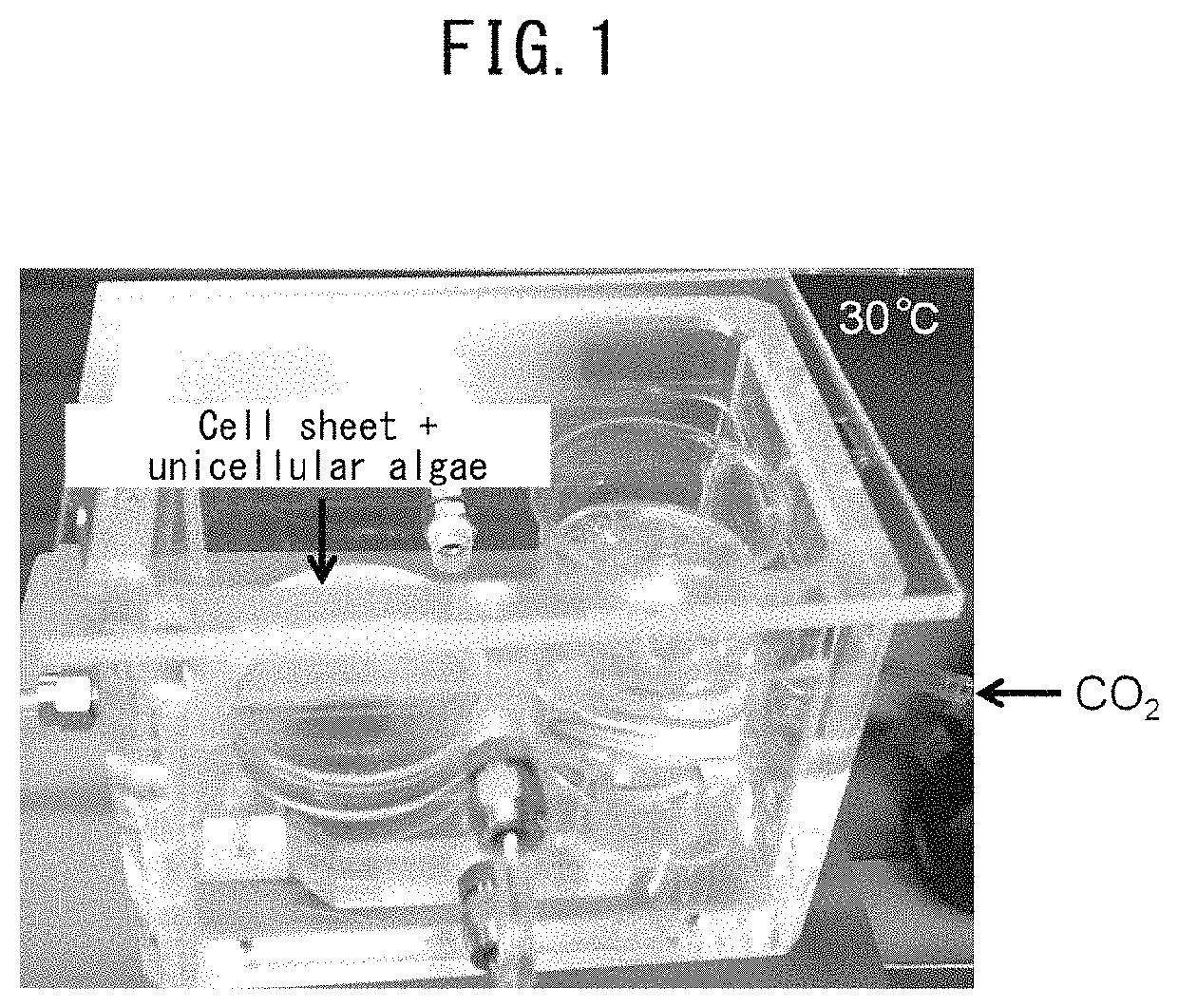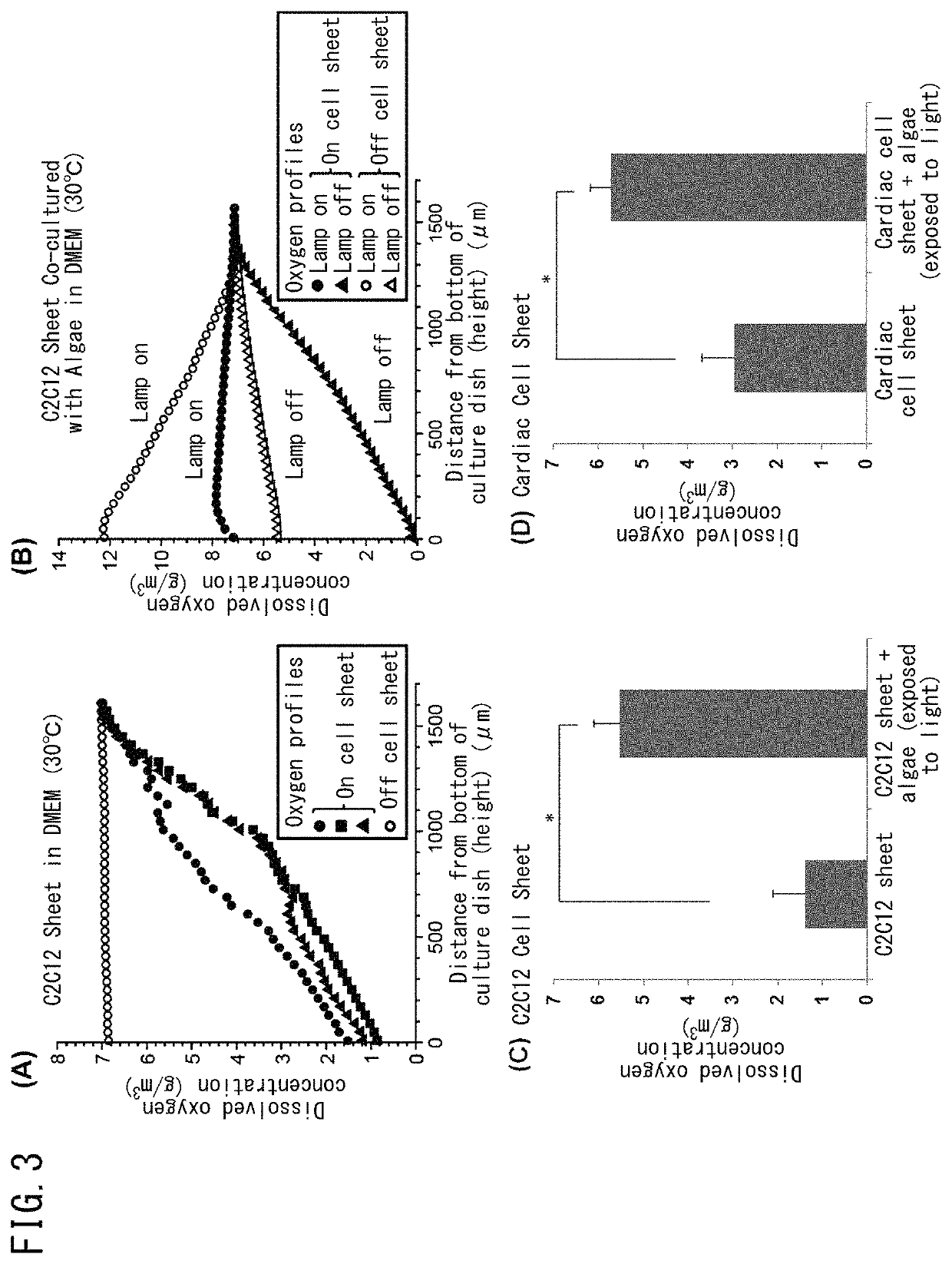Method for culturing animal cell composition, method for producing animal cell composition using same, and animal cell composition
a cell composition and cell technology, applied in the field of culturing animal cell composition, can solve the problems of limited therapeutic efficacy, difficult transplantation of cells to tissue, and necrosis of interior cells, and achieve the effects of reducing the number of cells
- Summary
- Abstract
- Description
- Claims
- Application Information
AI Technical Summary
Benefits of technology
Problems solved by technology
Method used
Image
Examples
example 1
[0082](Detection of Oxygen Production from Unicellular Algae)
[0083]The unicellular algae, Chlorococcum littorale, was confirmed as to whether it can be cultured in culture medium for mammalian cells and whether or not it is able to produce oxygen by photosynthesis (FIG. 2). Saturated oxygen concentration was defined as the oxygen concentration in the vicinity of the surface of the culture medium that contacts the gaseous phase (oxygen concentration of the region farthest from the bottom of the culture dish in FIG. 2B: approx. 7.4 g / m3). In the same manner as when using culture medium for algae, the unicellular algae were clearly determined to be able to produce oxygen by photosynthesis in excess of the saturated concentration even in the case of having cultured using culture medium for culturing mammalian cells, and were able to be cultured even when using culture medium for mammalian cells.
example 2
[0084](Co-Cultivation of Mammalian Cells and Unicellular Algae)
[0085]Cell sheets and unicellular algae were co-cultivated using mammalian cells (Table 1). Although the oxygen concentration of culture medium near the bottom of culture dishes in which C2C12 cell sheets were not present demonstrated a saturated state, oxygen concentration of culture medium at the bottom of culture dishes in which C2C12 cell sheets were present (left side of FIG. 2A) had decreased to a level approaching zero (FIG. 3A), thus demonstrating that the cell sheets are actively consuming oxygen. Oxygen concentration in the area where only unicellular algae are present and exposed to light was higher than the saturated oxygen concentration (FIG. 3B). Oxygen concentration of culture medium in the area where cell sheets and unicellular algae were both present and exposed to light (right side of FIG. 2A) was at the saturation level. On the basis thereof, mammalian cells and unicellular algae were determined to be ...
example 3
[0089](Co-Cultivation of Unicellular Algae and Rat Cardiac Cells)
[0090]Five-layered or 10-layered cell sheets were prepared under conditions of containing or not containing unicellular algae in order to fabricate thicker myocardial tissue. The 5-layered or 10-layered cardiac cell sheets containing unicellular algae demonstrated significant decreases in glucose consumption and lactate production in comparison with tissue obtained by culturing the cell sheets alone (FIGS. 7 and 8).
[0091]The ratio of lactate production to glucose consumption (L / G ratio) of the cells was used as an indicator in order to investigate whether the cells were engaged in aerobic respiration or anaerobic respiration. During anaerobic respiration, the L / G ratio is 2 in the case all pyruvate, which is the final metabolite of glucose metabolism, is converted to lactate. On the other hand, during aerobic respiration, a portion of the pyruvate is taken up into mitochondria and is completely oxidized by the tricarbo...
PUM
| Property | Measurement | Unit |
|---|---|---|
| temperature | aaaaa | aaaaa |
| temperature-responsive | aaaaa | aaaaa |
| temperature | aaaaa | aaaaa |
Abstract
Description
Claims
Application Information
 Login to View More
Login to View More - R&D
- Intellectual Property
- Life Sciences
- Materials
- Tech Scout
- Unparalleled Data Quality
- Higher Quality Content
- 60% Fewer Hallucinations
Browse by: Latest US Patents, China's latest patents, Technical Efficacy Thesaurus, Application Domain, Technology Topic, Popular Technical Reports.
© 2025 PatSnap. All rights reserved.Legal|Privacy policy|Modern Slavery Act Transparency Statement|Sitemap|About US| Contact US: help@patsnap.com



